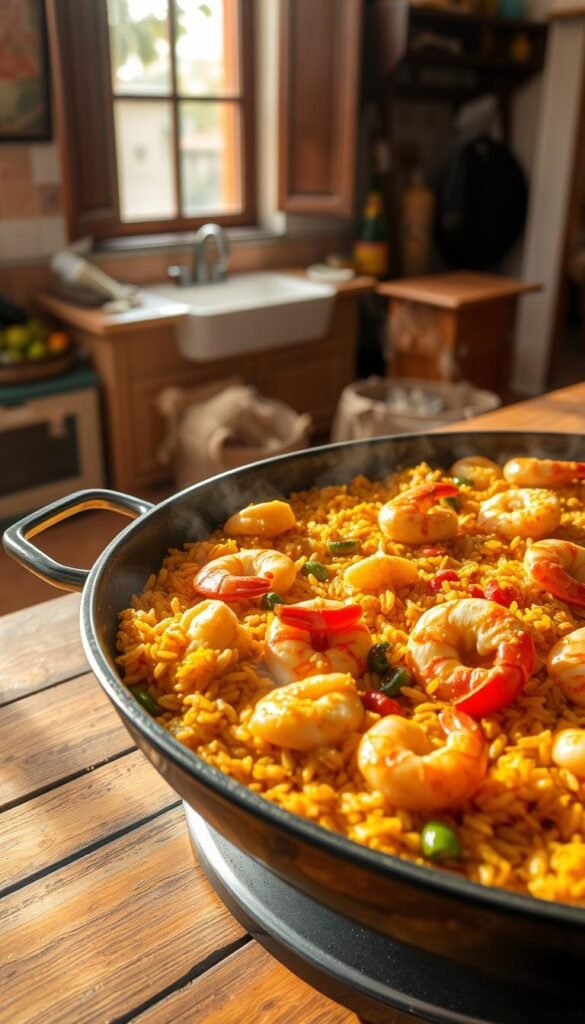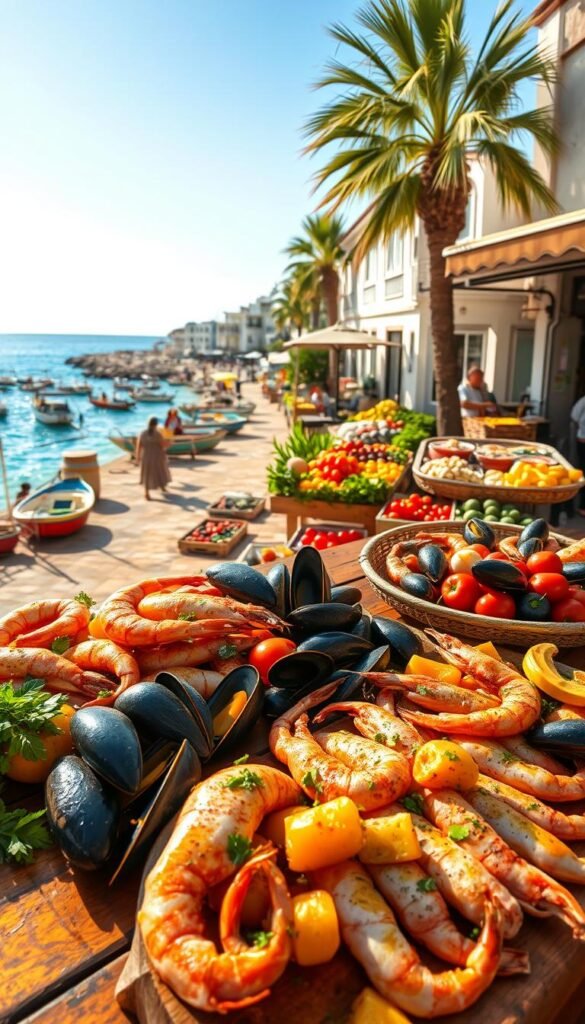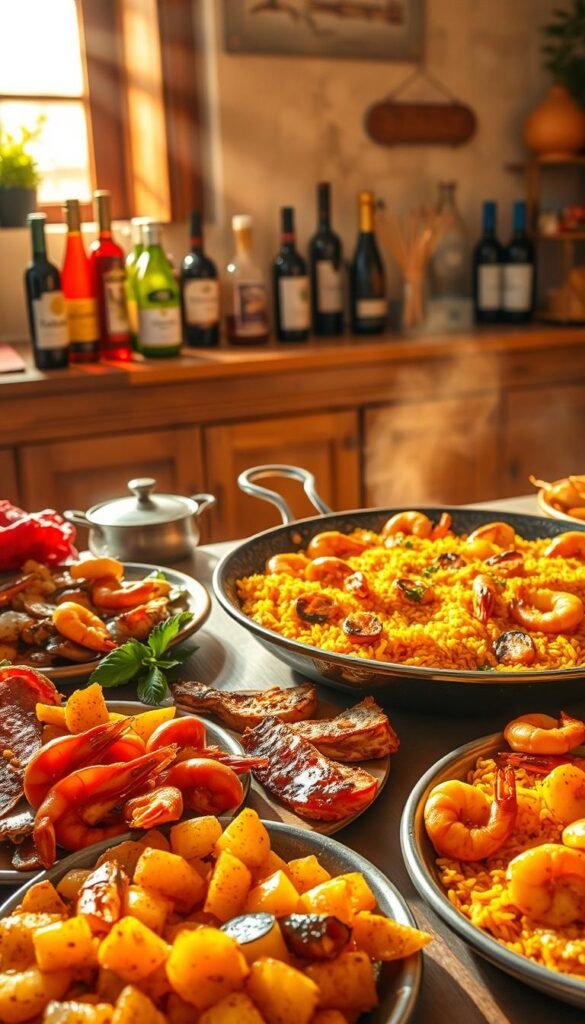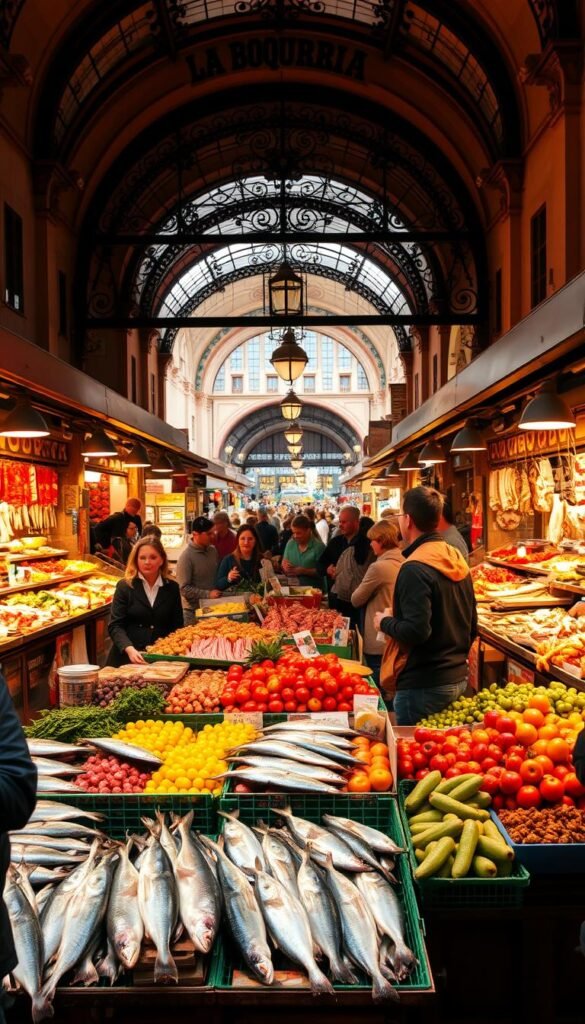Discover the Flavors of Spain Food

Imagine stepping into a bustling Spanish market. You smell fresh citrus, smoky paprika, and sizzling garlic. Each stand showcases centuries of tradition and innovation. Tasting Spanish cuisine is an amazing journey through Spain’s rich culture. For me, eating paella in Valencia was unforgettable. The flavors were magical!
This introduction invites you to explore Spain’s delicious food. We’ll talk about hearty paellas, innovative tapas, and the freshest seafood. Spanish cuisine celebrates life. This guide will help you start your food journey or dive deeper. You’ll get traditional recipes and learn about unique Spanish ingredients.
Key Takeaways:
- Dive into Spain’s diverse culinary heritage featuring traditional recipes and innovative dishes.
- Understand essential Spanish ingredients like olive oil and Bomba rice.
- Discover iconic dishes such as paella and tapas.
- Explore the role of seafood in coastal regional cuisines.
- Learn about Spain’s regional wine varieties and pairing suggestions.
Introduction to Spanish Cuisine
What I love most about Spanish cuisine is how it blends history and local variety. Historical Spanish cuisine shows us the past, mixing old practices with lively local tastes. Spain is a top producer of olive oil. This oil is key in many dishes, making them rich with every bite. It’s amazing to see old cooking methods still used today. They keep the true Spanish food tradition alive!
Historical Influences on Spanish Food
The Romans and Moors left a tasty impact on Spain’s food. The Arabs brought almonds. These nuts are now in sweet treats like turrón and marzipan. European and American flavors also blended in, matching Spanish tastes. Picture a Spanish kitchen missing garlic and olive oil. Hard, right? These are vital in Spanish cooking, used for frying and more.
Regional Diversity in Spain’s Culinary Scene
Spain’s culinary identity comes from its varied regions. Galicia, in the north, offers seafood and dairy. Andalucía, in the south, is famous for its crops and spices. Each place has its unique foods. Have you tried cocido madrileño? This Madrid stew shows the best local Spanish dishes. And let’s not forget tapas. They capture the variety of Spain’s tastes and traditions.
Essential Ingredients in Spanish Food
In Spain, authentic recipes are full of great tastes and colors. Spanish olive oil, called “liquid gold,” is central. It’s more than just for cooking; it boosts flavors in many dishes. Did you know that Spain is a top producer of olive oil? It’s very impressive!

Olive Oil: The Heart of Spanish Cooking
Let’s explore why Spanish olive oil is amazing. It’s key in kitchens, especially for making sofrito. This mix of garlic, tomato, and onion is a start for many dishes. Olive oil is used in salads, for sautéing veggies, or in marinades. It captures the soul of Spanish food. Imagine a salad with this oil, celebrating the sunny olive groves it came from!
Spices and Herbs That Define Flavors
But Spanish food wouldn’t be the same without its *spices and herbs*. Saffron, though from India, is big in Spain. It makes dishes like paella golden and tasty. Spanish paprika adds a smoky touch to chorizo and stews. And don’t forget dry peppers like Pimiento Choricero. They give unique tastes to dishes like Potatoes a la Riojana.
Parsley is also key, adding freshness to many dishes. Bay leaves bring a hint of bitter, great in marinades and stews. With white wine, these ingredients make Spanish cooking truly special.
Iconic Spanish Dishes You Must Try
Spain’s food is full of history and different tastes. Let’s talk about the most popular Spanish dishes. You must try them when you explore Spanish food!
Paella: Spain’s Signature Rice Dish
Did you know *paella recipe* comes from Valencia? It has two main types: Paella Valenciana with rabbit and chicken, and Seafood Paella with shrimp and mussels. The dish’s star is saffron rice, showing off a bright color and nutty taste.

Tapas: Small Plates for Big Flavors
In Spain, *tapas culture* means sharing small dishes with friends. Try patatas bravas, or a tomato-based gazpacho for a fresh taste. Pimientos de Padrón are small green peppers, sometimes a bit spicy. Tapas let you enjoy many tastes!
Jamón Ibérico: A Culinary Treasure
*Jamón Ibérico* is the jewel of Spanish food. This special ham tastes rich and nutty. It comes from pigs that eat acorns. You can eat it on tostas de tomate y jamón or by itself. It showcases Spain’s food artistry.
| Dish Name | Region | Main Ingredients |
|---|---|---|
| Paella | Valencia | Rice, Saffron, Chicken, Rabbit, Seafood |
| Patatas Bravas | Madrid | Potatoes, Spicy Sauce |
| Gazpacho | Andalusia | Tomatoes, Peppers, Garlic, Olive Oil |
| Jamón Ibérico | Extremadura | Pork, Salt |
These famous meals show off Spain’s many regions and its strong food traditions. Try these delicious dishes and get a taste of Spain’s heart and soul!
The Role of Seafood in Spanish Cuisine
Seafood is very important to Spanish coastal food. Spain eats a lot of fish, second only to Japan. Seafood is a big part of meals, celebrations, and cooking in Spain.

Popular Seafood Dishes in Coastal Regions
Galicia and Andalusia love their seafood. Galicia enjoys fresh clams, mussels, and razor clams. Ever tasted percebes? These rare barnacles are expensive but taste amazing. Cadiz offers pescaíto frito, a yummy fried fish mix.
How Fresh Fish is Prepared in Spain
Spain is famous for its simple seafood cooking. They use little prep to keep the natural tastes. Try gambas al ajillo, shrimp cooked in olive oil and garlic. It’s delicious! Gambas blancas de Huelva are known for their sweet taste. The way Spain cooks seafood makes it special and loved.
Spanish Wine: A Perfect Pairing
Diving into Spanish wines is like going on a flavor trip. You’ll find crisp whites in Galicia and rich reds in Rioja. Each area brings its own taste to the table. This turns meals into more than just eating but a joy for your taste buds. Ready to discover the best wine pairings for Spanish meals?

Region-Specific Wines to Explore
Spain is full of amazing wines to try. Verdejo is a crisp white from Rueda. It’s great with raw fish and light salads. Albarino from Galicia is perfect with seafood like prawns. Looking for something fuller? Godello from Monterrei matches well with roasted meats.
Love Rioja wines? Try Viura. It’s a tasty white that’s great with paella. For lighter reds, Mencía from Galicia is ideal with fish and grilled octopus. Garnacha Blends from Catalonia are great with sausages and tapas. The top Spanish red, Tempranillo, goes well with stews and meats.
Pairing Wines with Classic Spanish Dishes
Albariño enhances seafood like tuna and scallops with its crispness. Verdejo is flexible, perfect with mussels and tapas. It suits many Spanish favorites.
For big flavors, pick Tempranillo wines. They’re great with grilled lamb and stews. For celebrations, Cava is wonderful with fried foods and desserts. Sherry wines, like Pedro Ximénez, pair beautifully with sweets and cheese.
Choosing the right Spanish wine can uplift any meal. Open a bottle and discover the amazing pairings with Spanish dishes!
The Evolution of Spanish Food
Spanish food is always changing. It mixes old traditions with new ideas. You can enjoy classic meals like paella or try something new like a deconstructed tortilla española. This mix makes Spanish food special!

Traditional vs. Modern Spanish Cuisine
Spain’s food has influences from many cultures. The Moors brought rice and spices. The Greeks introduced olive oil. Foods like gazpacho and patatas bravas are deeply loved in Spain. And ingredients like tomatoes and chocolate from the Americas made Spain’s food even better.
Now, chefs in Spain are using new methods to cook. They’re changing old recipes into something new and exciting. Ferrán Adrià started this trend, using art and science to cook.
Influential Chefs Redefining Spanish Food
Chefs like José Andrés and José Pizarro are making Spanish food known worldwide. They use top-quality items like Jamón Ibérico. San Sebastián is full of amazing restaurants. It shows how good Spain’s food really is.
Spain’s food scene is vibrant because it respects its past but also tries new things. Eating a meal in Spain means enjoying something made with care, history, and creativity.
Festivals and Food Celebrations in Spain
Hey foodies! Spain is known for its lively food festivities. These mix culture, tradition, and tastes in a fun way! They have everything from tomato fights to famous food meetings. These events show off Spain’s food history and their love for tasty meals.
La Tomatina: A Feast of Tomatoes
Ever dreamed of being in a huge food fight? La Tomatina in Buñol, Valencia, gives you that chance! It happens in late August and started in 1945. Picture thousands in the streets, tossing ripe tomatoes at each other. It’s wild, fun, and super messy! But it’s not all about tomatoes. There are also dishes like paella and tapas, making it a great food adventure.

San Sebastián Gastronomika: A Culinary Conference
Next, let’s explore the San Sebastián Gastronomika. It’s a big deal in the food world. Chefs and food fans from all over meet here in October. It’s the best place to find out about new food trends and skills. This event also talks about using fresh, earth-friendly ingredients. It lets people dive into Spanish traditions and culture. Learning from top chefs is a fantastic way to enjoy Spanish food events!
But these events do more than entertain. They help local businesses by giving small producers a chance to show off their stuff. Other festivals, like the Galician Octopus Festival and the Wine Battle in Haro, also highlight Spain’s culinary greatness. Whether you’re covered in tomato juice or enjoying gourmet meals, Spanish food festivals let you experience Spain’s rich culture and amazing tastes. So, get ready for a delicious journey—Spain is waiting for you!
Spain Food Markets: A Culinary Adventure
The best way to really know Spanish food is by visiting its food markets. These places buzz with life. You’ll see both locals and visitors checking out fresh veggies, meats, and fish. The smells, sights, and sounds are amazing!
Exploring La Boqueria in Barcelona
Since 1217, La Boqueria has been a key spot in Barcelona. From the first step inside, you’re greeted with the smells of Jamón ibérico, chorizo, and lomo. And the beautiful fruits and juices are too good to pass by. They’re perfect for a quick, refreshing stop.
This place makes shopping fun. It’s like a food lover’s heaven. Here, you find all you need for Spanish dishes. There’s amazing seafood, cheeses, and smoothies. La Boqueria isn’t just shopping; it’s a full-on food journey.

Mercado de San Miguel in Madrid
In Madrid, the Mercado de San Miguel is a treasure since 1916. It’s known for its beauty and gourmet foods. You’ll wander by Manchego cheese, Jamón ibérico, and tasty paella. Plus, there’s a cozy wine and cava bar to enjoy Spain’s best drinks.
This market blends old and new perfectly. Here, you can try classic and new dishes. And the vendors love to share their food stories with you. It makes the visit extra special.
| Market | City | Specialties | Established |
|---|---|---|---|
| La Boqueria | Barcelona | Jamón ibérico, chorizo, fresh juices | 1217 |
| Mercado de San Miguel | Madrid | Manchego cheese, paella, wine & cava bar | 1916 |
Shopping at these markets means diving into local culture and tastes. Spanish cooking gets its fame from here. Both La Boqueria and Mercado de San Miguel give amazing experiences. They thrill all who love food or just want to try something new.
Vegan and Vegetarian Options in Spanish Cuisine
Spanish vegetarian dishes are full of amazing flavors and textures. They use fresh and local veggies. If you love vegetarian Spanish food or want vegan choices, Spain has many options for you!

Plant-Based Dishes to Try
Try many vegetarian dishes in Spain. Gazpacho, Salmorejo, and Paella de Verduras are famous across the country. In cities like Barcelona or Cordoba, there are lots of vegetarian tapas. These include Pan con Tomate, Patatas Bravas, and Croquetas.
You can enjoy these as a snack or a meal. Also, look for regional dishes like sweet fried peppers and onions on baguette slices in Basque style. These add color and taste to any vegetarian meal.
Local Ingredients for a Vegetarian Fare
The beauty of Spanish vegetarian food is its use of veggies, olive oil, and herbs. About 8% of people in Spain eat vegetarian or mostly vegetarian. Dishes are made with ingredients like olive oil, smoked paprika, and fresh veggies. In Cordoba’s Mercado Victoria, try different vegetarian and vegan dishes. Visit Ermita de la Candelaria too. It’s known for dishes like creamy Russian salad and a special Samfaina.
Even Spanish desserts are vegetarian. The Pastel Cordobés, with squash jam and puff pastry, is yum. And Smoky Spanish tomato dip goes great with vegan Padron peppers. They make a delicious appetizer.
More people in Spain are choosing vegetarian food. This shows in the growing number of vegetarian places and plant-based tapas everywhere. Spain offers many choices like Vegetable Paella, Pisto Manchego, and Gazpacho for vegetarian and vegan tastes.
Dining Etiquette in Spain
Eating in Spain is more than just meals; it’s a dive into their culture and traditions. Grasping Spanish dining etiquette makes eating there really nice.
Understanding Meal Times and Customs
In Spain, lunch happens between 1:30 PM and 3:30 PM. Dinners start from 9:00 PM to midnight. If you’re out of these times, bars might have snacks like tortilla de patatas and ensaladilla rusa.
You might see used napkins and olive pits on the floor in bars. It’s typical of the bar scene there.
Spaniards also follow certain dining rules. Bread comes without butter, sitting at the edge of your plate. Always keep your hands visible on the table. Dishes should be passed to the left. The most honored guests sit at the table’s head.

Tipping Practices and Dining Etiquette
While tipping in Spain isn’t a must, it is welcomed. For meals above €15, leaving a €1-2 tip is usual. If the service was great, up to a 10% tip is okay. But you don’t need to tip for drinks or breakfast.
Knowing how to catch a waiter’s attention helps. You can wave, make gestures, or say “perdón.” To ask for the bill, pretend to write a check in the air.
Getting the hang of Spanish dining etiquette means you can enjoy meals respectfully. By following these traditions, you’ll really get into the cultural depth of Spanish dining.
Conclusion: Exploring Spanish Cuisine in the United States
As we finish our journey through Spain, it’s exciting to see Spanish cuisine’s impact in the United States! Traditional dishes and new mixes show Spanish food’s influence. Mole, empanadas, and paella are loved worldwide. So, where can you taste these delicious foods?
Finding Authentic Spanish Restaurants
There are many Spanish restaurants across the USA for authentic eating! Cities like New York, Miami, and Los Angeles have great places. Ever visited Jaleo by José Andrés or Casa Mono by Mario Batali? They’re great for trying tapas like patatas bravas and gambas al ajillo. You don’t have to travel far to enjoy a piece of Spain!
Tips for Cooking Spanish Dishes at Home
Want to cook Spanish food at home? It’s not as hard as it seems! First, get ingredients like olive oil, saffron, and pimentón. Making a tortilla Española showed me how simple ingredients can make tasty food! Try making paella too. Just get a good pan and fresh seafood. And make some sangria! It adds to your Spanish meal.
Bringing Spanish cuisine into your home is about more than food. It’s about embracing the culture and joys of sharing meals. Whether you eat out or cook, explore Spanish flavors with your loved ones. Enjoy your food journey and ¡buen provecho!